
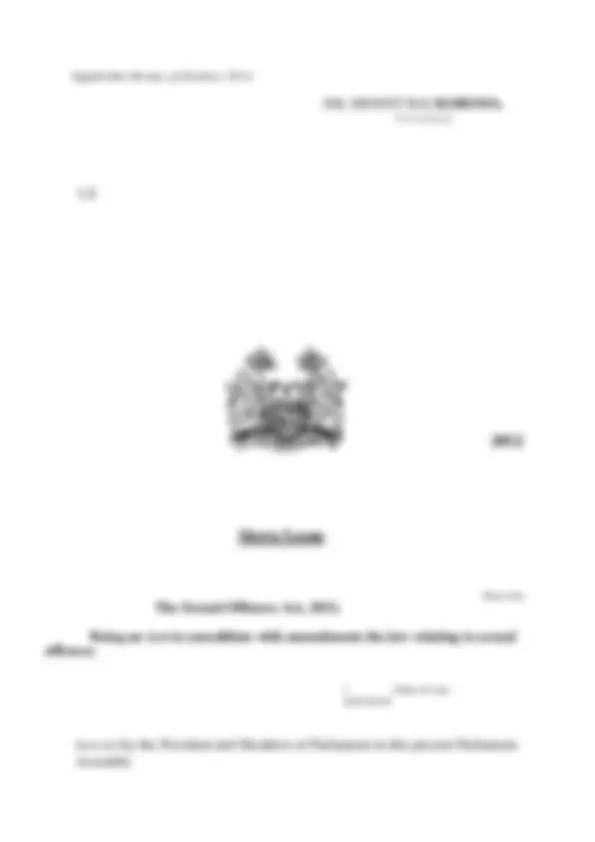
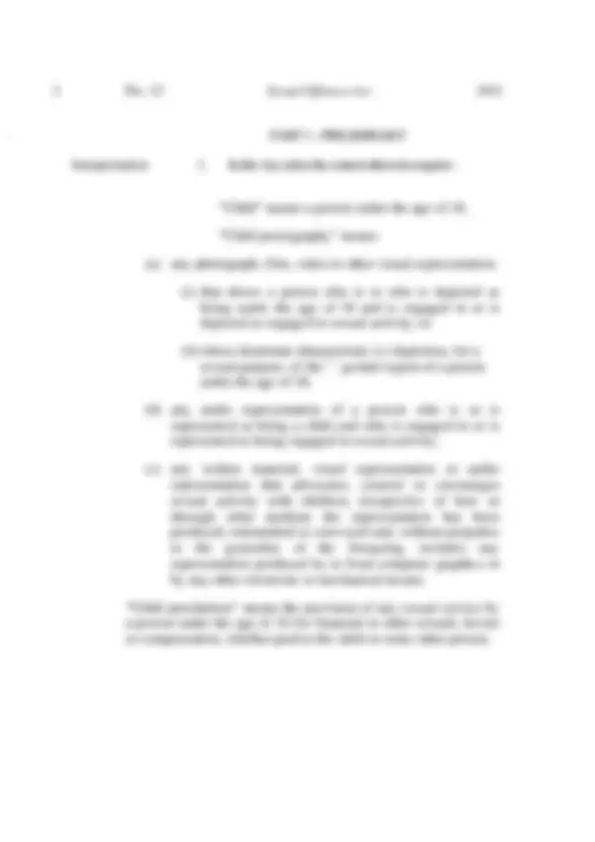
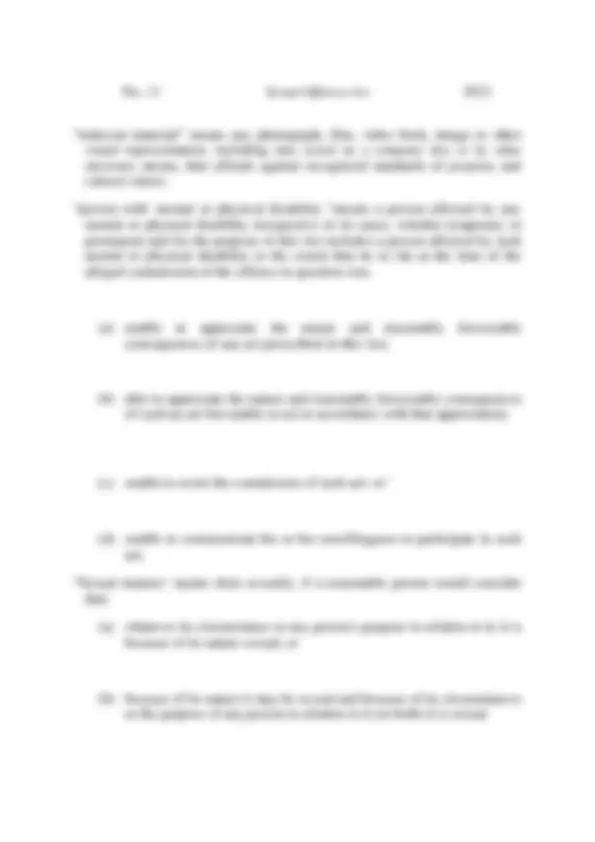

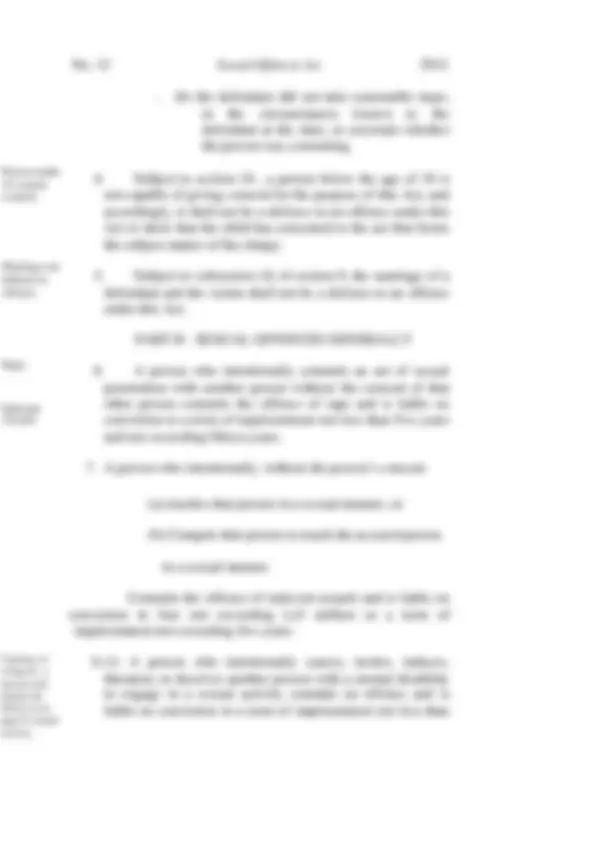
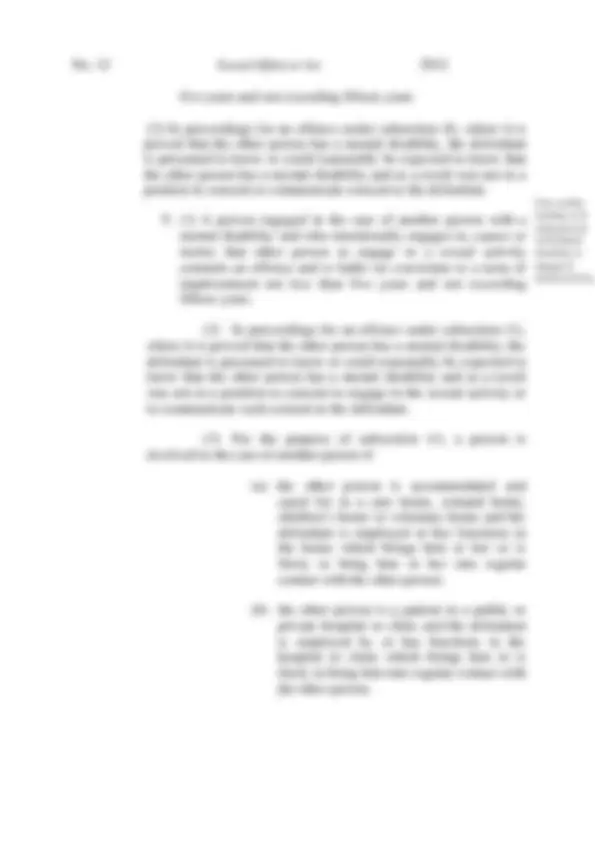
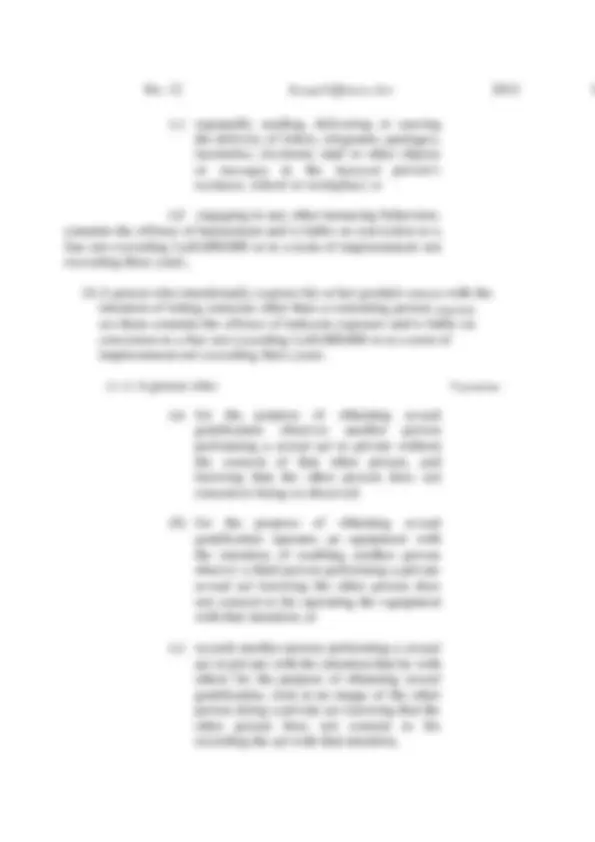
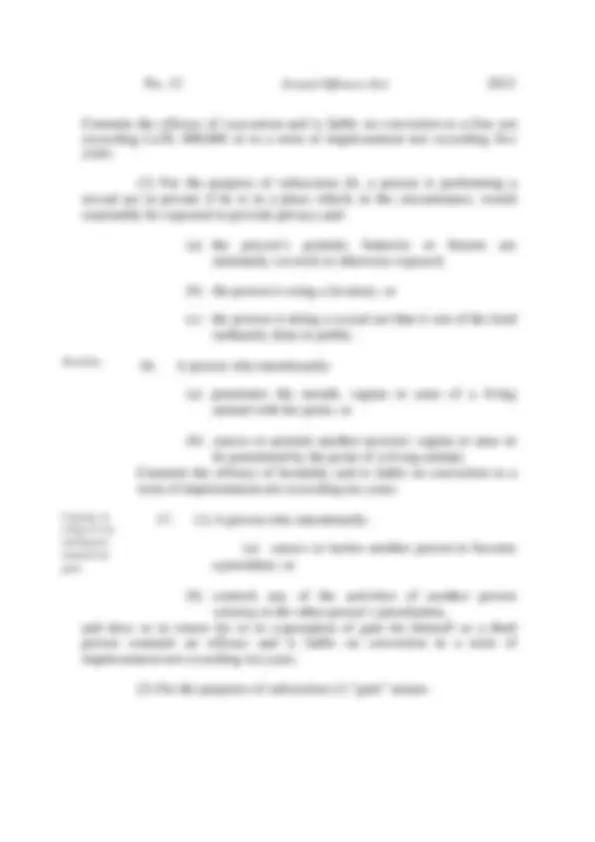
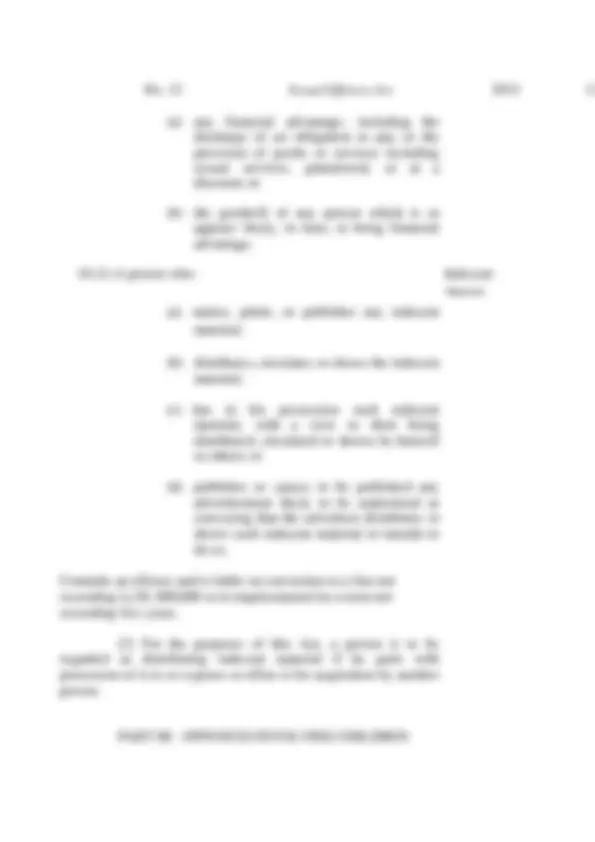
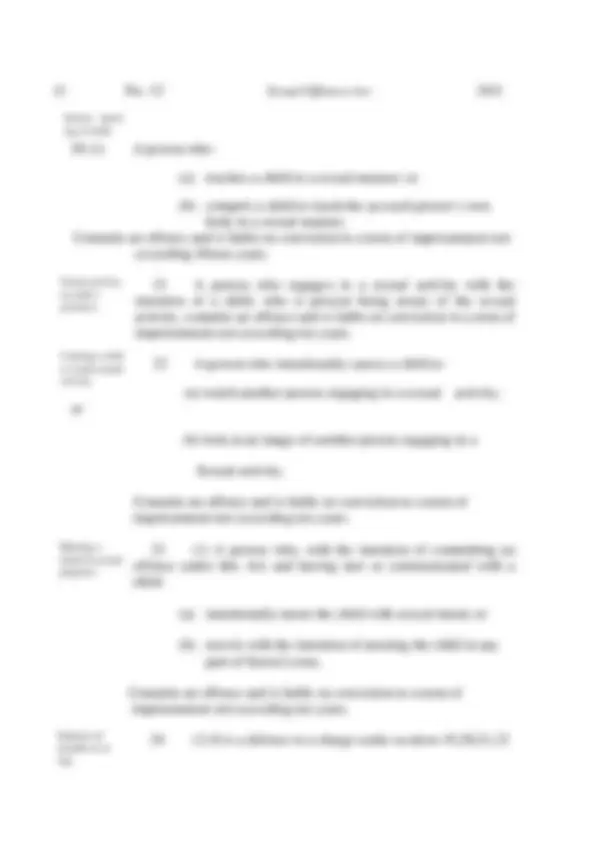
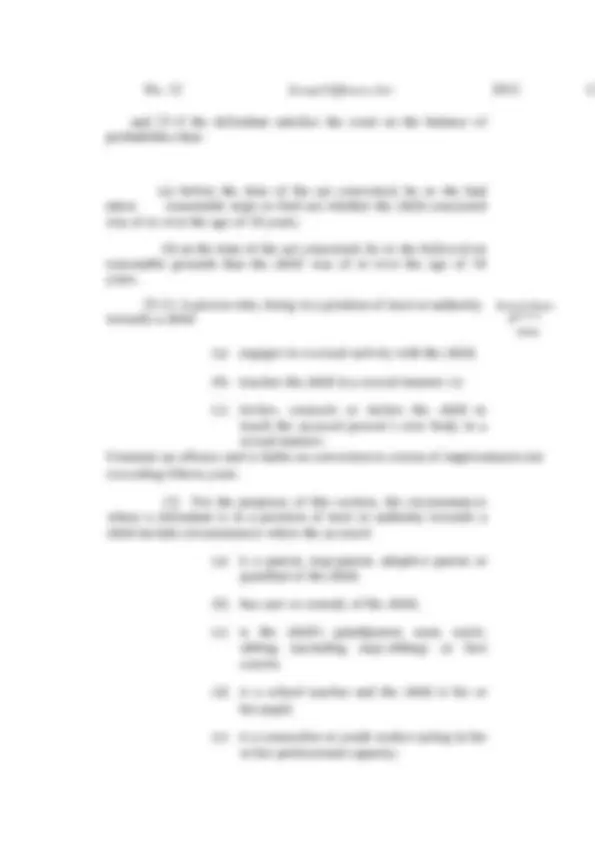
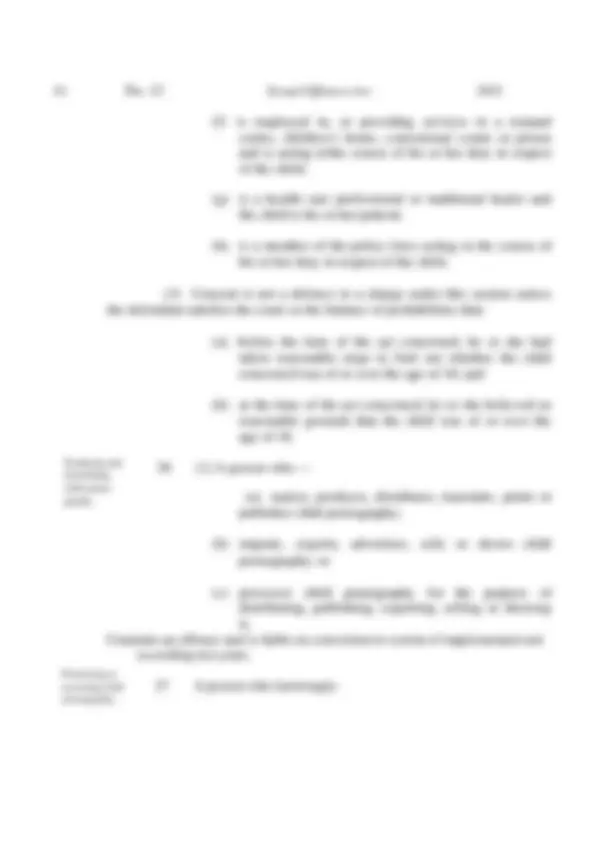
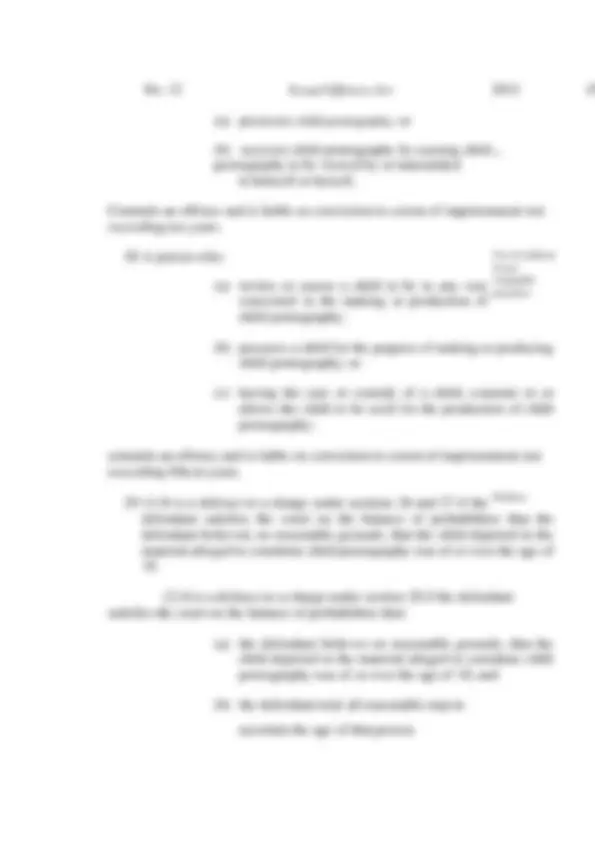
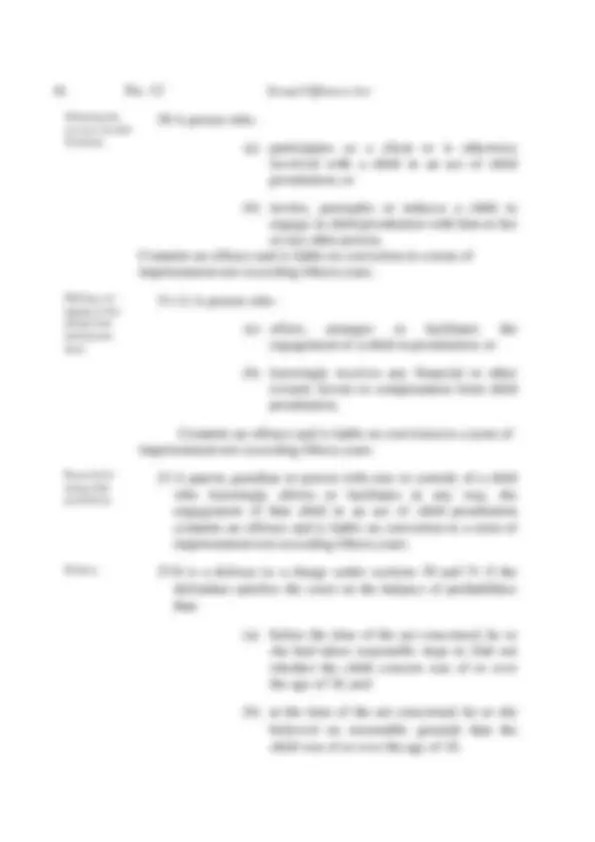
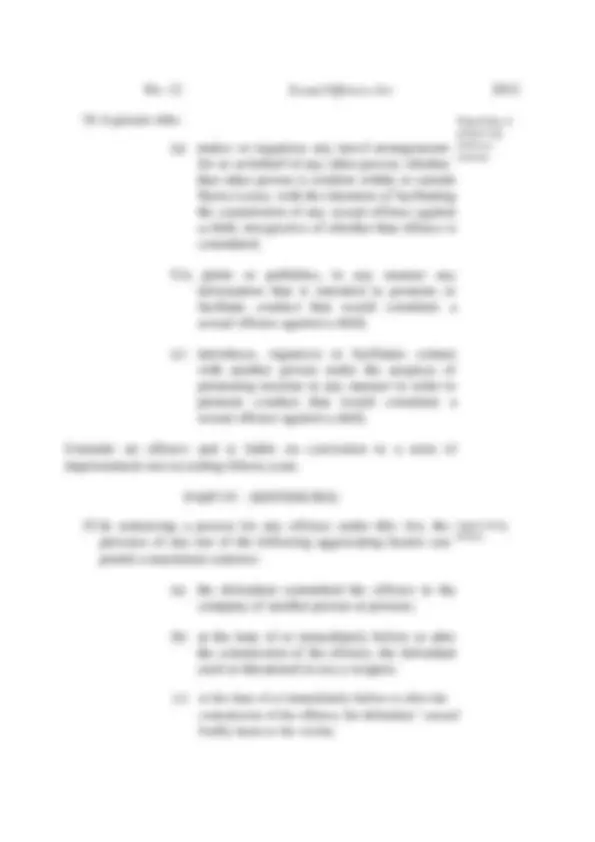
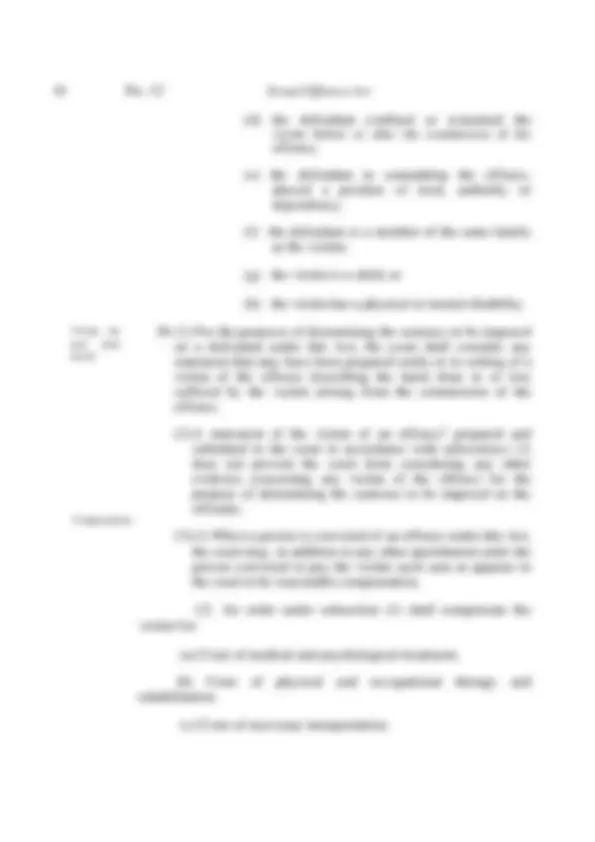
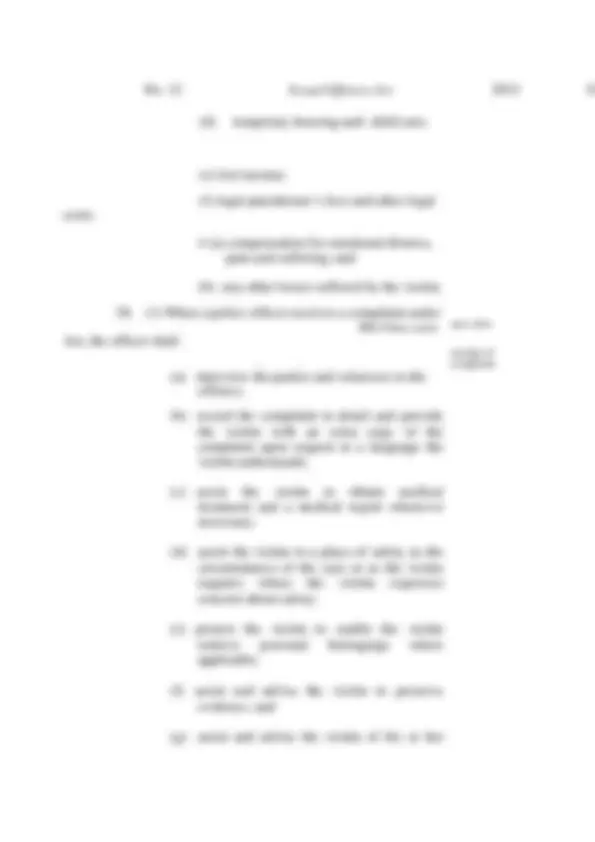
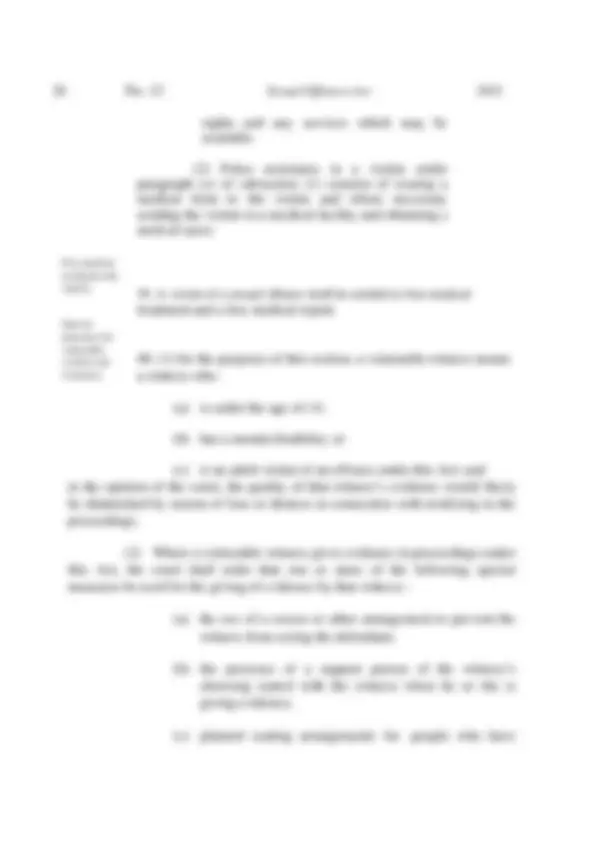
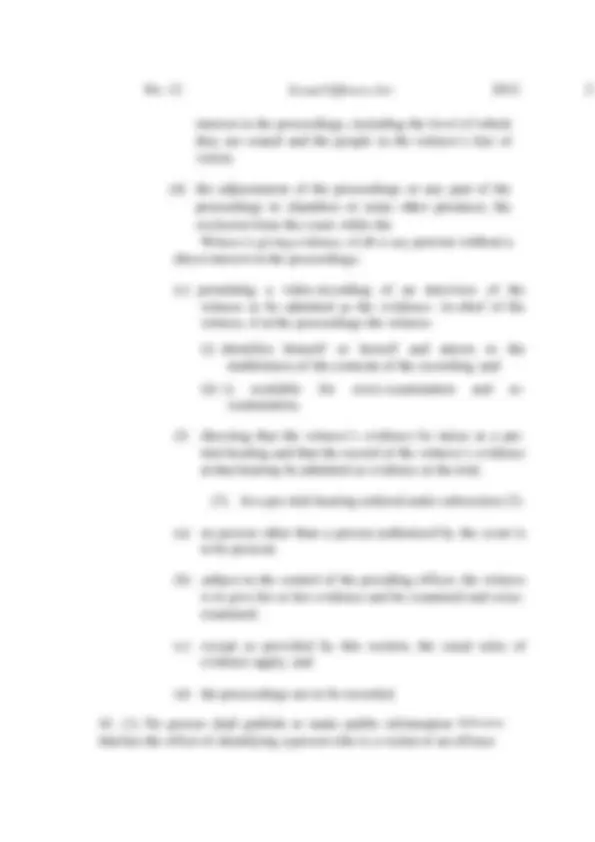
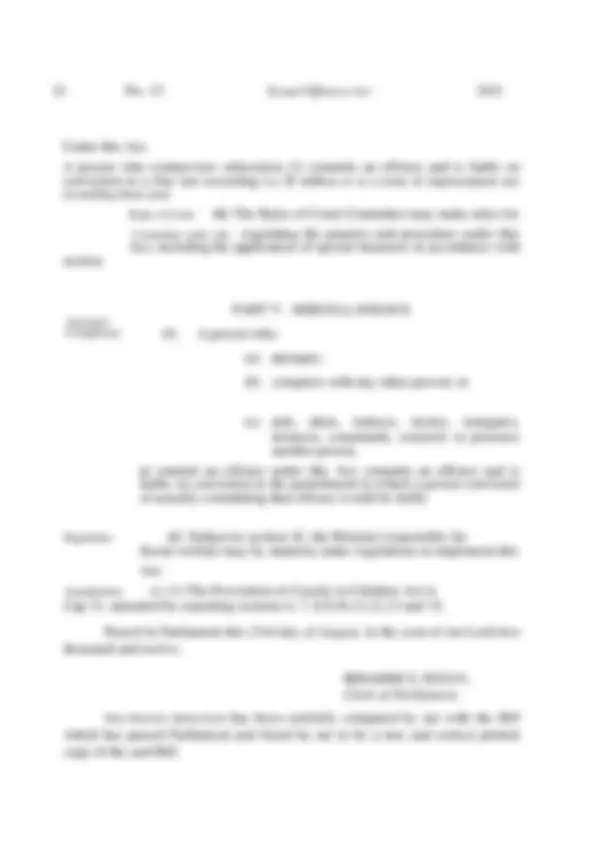



Study with the several resources on Docsity

Earn points by helping other students or get them with a premium plan


Prepare for your exams
Study with the several resources on Docsity

Earn points to download
Earn points by helping other students or get them with a premium plan
Community
Ask the community for help and clear up your study doubts
Discover the best universities in your country according to Docsity users
Free resources
Download our free guides on studying techniques, anxiety management strategies, and thesis advice from Docsity tutors
The Sexual Offences Act 2012 of Sierra Leone, focusing on sections related to sexual abuse, consent, and child protection. It defines various terms, specifies offenses, and outlines penalties for individuals who engage in sexual activities with persons with mental disabilities, children, or animals. It also covers sexual harassment and child pornography.
What you will learn
Typology: Summaries
1 / 29

This page cannot be seen from the preview
Don't miss anything!






















Section.
PART 1- PRELIMINARY
a _ '-No. 12 Sexual Offences Act 2012
PART IV- SENTENCENG
PART V- MISCELLANEOUS
Interpretation 1. In this Act, unless the context otherwise requires -
“Child” means a person under the age of 18,
“Child pornography” means-
(a) any photograph, film, video or other visual representation-
(i) that shows a person who is or who is depicted as being under the age of 18 and is engaged in or is depicted as engaged in sexual activity; or
(ii) whose dominant characteristic is t depiction, for a sexual purpose, of the v
(b) any audio representation of a person who is or is represented as being a child and who is engaged in or is represented as being engaged in sexual activity;
’ genital region of a person under the age of 18;
(c) any written material, visual representation or audio representation that advocates, counsel or encourages sexual activity with children, irrespective of how or through what medium the representation has been produced, transmitted or conveyed and, without prejudice to the generality of the foregoing, includes any representation produced by or from computer graphics or by any other electronic or mechanical means;
“Child prostitution” means the provision of any sexual service by a person under the age of 18 for financial or other reward, favour or compensation, whether paid to the child or some other person;
“indecent material” means any photograph, film, video book, image or other visual representation, including data stored on a computer disc or by other electronic means, that offends against recognized standards of propriety and cultural
“person with' mental or physical disability “means a person affected by any mental or physical disability irrespective of its cause, whether temporary or permanent and for the purpose of this Act includes a person affected by such mental or physical disability to the extent that he or she at the time of the alleged commission of the offence in question was-
values;
(a) unable to appreciate the nature and reasonably foreseeable consequences of any act prescribed in-this Act;
(b) able to appreciate the nature and reasonably foreseeable consequences of such an act but unable to act in accordance with that appreciation;
(c) unable to resist the commission of such act: or '
(d) unable to communicate his or her unwillingness to participate in such act,
“Sexual manner,,
(a) whatever its circumstance or any person's purpose in relation to it, it is because of its nature sexual; or
means done sexually, if a reasonable person would consider that-
(b) because of its nature it may be sexual and because of its circumstances or the purpose of any person in relation to it (or both) it is sexual
Belief in consent not a defence.
(h) the accused induces the person to engage in the activity by abusing a position of trust, power or authority;
(i) the person, having consented to engage in the sexual activity, expresses, by words or conduct a lack of agreement to continue to engage in the activity.
(3) In determining whether or not a person consented to the act that forms the subject matter of the charge, the court shall have regard to the following
(a) the fact that a person did not say or do anything to indicate consent to a sexual act is enough to show that the act took place without that person’s consent: and
(b) a person is not to be regarded as having consented to a sexual act just because-
(i) the person did not physically resist;
(ii) the person did not sustain physical injury; or
(iii) on that or an earlier occasion the person freely agreed to engage in another sexual act with that person or some other person.
(a) the defendant’s belief arose from his or her-
(i) self-induced intoxication; or
(ii) recklessness or wilful blindness; or
Care worker causing or in- citing person with mental disability to engage in sexual activity.
five years and not exceeding fifteen years
(2) In proceedings for an offence under subsection (I), where it is proved that the other person has a mental disability, the defendant is presumed to know or could reasonably be expected to know that the other person has a mental disability and as a result was not in a position to consent or communicate consent to the defendant.
(2) In proceedings for an offence under subsection (1), where it is proved that the other person has a mental disability; the defendant is presumed to know or could reasonably be expected to know that the other person has a mental disability and as a result was not in a position to consent to engage in the sexual activity or to communicate such consent to the defendant.
(3) For the purpose of subsection (1), a person is involved in the care of another person if-
(a) the other person is accommodated and cared for in a care home, remand home, children’s home or voluntary home and the defendant is employed or has functions in the home which brings him or her or is likely to bring him or her into regular contact with the other person;
(b) the other person is a patient in a public or private hospital or clinic and the defendant is employed by or has functions in the hospital or clinic which brings him or is likely to bring him into regular contact with the other person. u
(4) Marriage between the defendant and the other person shall be a defence in proceedings under subsection ( 1 ) and the onus of proof of the existence of the marriage shall be on the defendant.
(c) repeatedly sending, delivering or causing the delivery of letters, telegrams, packages, facsimiles, electronic mail or other objects or messages to the harassed person’s residence, school or workplace;
(d) engaging in any other menacing behaviour, commits the offence of harassment and is liable on conviction to a fine not exceeding Lei0,000,000 or to a term of imprisonment not exceeding three years.
or
(a) for the purpose of obtaining sexual gratification observes another person performing a sexual act in private without the consent of that other person, and knowing that the other person does not consent to being so observed:
Voyeurism.
(b) for the purpose of obtaining sexual gratification operates an equipment with the intention of enabling another person observe a third person performing a private sexual act knowing the other person does not consent to his operating the equipment with that intention; or
(c) records another person performing a sexual act in private with the intention that he with others for the purpose of obtaining sexual gratification, look at an image of the other person doing a private act knowing that the other person does not consent to his recording the act with that intention,
Bestiality.
Causing, in- citing or con- trolling pro- stitution for gain.
Commits the offence of voyeurism and is liable on conviction to a-fine not exceeding Le20, 000,000 or to a term of imprisonment not exceeding five years.
(2) For the purpose of subsection (I), a person is performing a sexual act in private if he is in a place which, in the circumstance, would reasonably be expected to provide privacy and-
(a) the person’s genitals, buttocks or breasts are minimally covered or otherwise exposed;
(b) the person is using a lavatory; or
(c) the person is doing a sexual act that is not of the kind ordinarily done in public.
(a) penetrates the mouth, vagina or anus of a living animal with his penis; or
(b) causes or permits another person's vagina or anus to be penetrated by the penis of a living animal, Commits the offence of bestiality and is liable on conviction to a term of imprisonment not exceeding ten years.
(a) causes or incites another person to become a prostitute; or
(b) controls any of the activities of another person relating and does so in return for or in expectation of gain for himself or a third person commits an offence and is liable on conviction to a term of imprisonment not exceeding ten years.
to the other person’s prostitution,
(2) For the purposes of subsection (1) “gain” means-
and 23 if the defendant satisfies the court on the balance of probabilities that-
(a) before the time of the act concerned, he or she had taken reasonable steps to find out whether the child concerned was of or over the age of 18 years;
(b) at the time of the act concerned, he or she believed on reasonable grounds that the child' was of or over the age of 18 years.
25 (1) A person who, being in a position of trust or authority Sexual abuse towards a child- P trust.
erson in
(a) engages in a sexual activity with the child;
(b) touches the child in a sexual manner; or
(c) invites, counsels or incites the child to touch the accused person’s own body in a sexual manner, Commits an offence and is liable on conviction to a term of imprisonment not exceeding fifteen years.
(2) For the purposes of this section, the circumstances where a defendant is in a position of trust or authority towards a child include circumstances where the accused-
(a) is a parent, step-parent, adoptive parent or guardian of the child;
(b) has care or custody of the child;
(c) is the child's grandparent, aunt, uncle, sibling (including step-sibling) or first cousin;
(d) is a school teacher and the child is his or her pupil;
(e) is a counsellor or youth worker acting in his or her professional capacity;
Producing and distributing child porno- graphy.
Possessing or accessing child pornography.
(f) is employed in, or providing services in a remand centre, children’s home, correctional centre or prison and is acting in'the course of his or her duty in respect of the child;
(g) is a health care professional or traditional healer and the child is his or her patient;
(h) is a member of the police force acting in the course of his or her duty in respect of the child,
(3) Consent is not a defence to a charge under this section unless the defendant satisfies the court on
(a) before the time of the act concerned, he or she had taken reasonable steps to find out whether the child concerned was of or over the age of 18; and
the balance of probabilities that-
(b) at the time of the act concerned, he or she believed on reasonable grounds that the child was of or over the age of 18.
26 (1) A person who —
(a) makes, produces, distributes, transmits, prints or publishes child pornography;
(b) imports, exports, advertises, sells or shows child pornography; or
(c) possesses child pornography for the purpose of distributing, publishing, exporting, selling or showing it, Commits an offence and is liable on conviction to a term of imprisonment not exceeding ten years.
27 A person who knowingly-